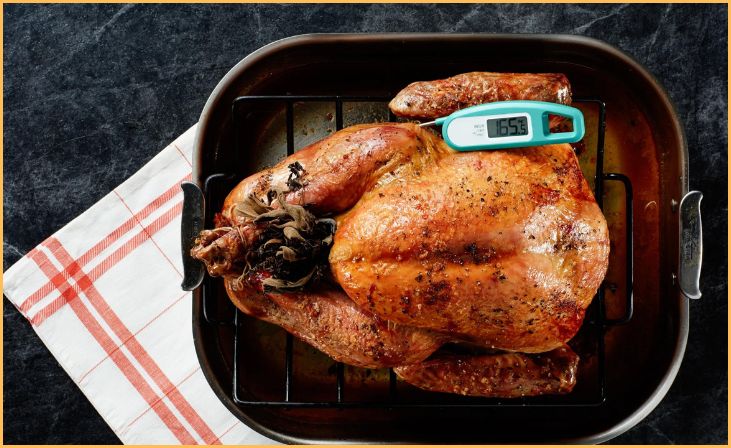Are you trying to find out the internal temp of steak on grill or about the doneness of your cooking? If yes, this article is for you. To grill, a steak seems to be an easy task, but there is some skill involved, especially when it comes to doneness. The density of the steak, as well as the heat of the grill, will impact how long it takes to cook when it’s done. In addition, the internal temperature is something that tells you whether your steak is ready or not.
Each level of doneness has a target temperature that may be tested using a meat thermometer, ranging from rare to well.
To ensure that the meat cooks evenly, let it get to room temperature before placing it on the grill. (Place the packed steak on the counter about a half-hour to 45 minutes before cooking.) This guarantees that the entire steak is the same temperature throughout, allowing it to cook evenly and preventing a charred outside with a chilly center.
Read Also: 10 Popular American Breads Eaten Daily
Why Should We Temp A Steak?

Tempering a steak can be done for a number of reasons. See below:
- To begin, keep in mind that we don’t always have control over the environment in which we cook, especially if we’re cooking outside. Many external conditions might have an impact on our cooking process. Temping a steak is the most excellent approach to get consistent cooking outcomes under variable cooking conditions.
- Second, you’ll want to ensure that the middle of your fillet is at the appropriate temperature to safeguard yourself and others you’re serving from foodborne diseases. The last thing you want to do is make a friend or family member ill by serving them undercooked meat. Salmonella poisoning is unpleasant, and you don’t want to be the source of it.
- Last but not least, temping a steak can assist you in refining your cooking method so that you may get consistent outcomes every time you cook. It’s quite fascinating to be able to see what’s happening on within the meat while watching it cook from the outside. Understanding the internal processes is essential for obtaining the perfect steak that you will be happy to present.
Grilling Times and Internal Temp of Steak on Grill
How can you determine when the middle of your steak is cooked to perfection? The best method is to take the internal temp of steak on grill.
When the steak’s internal temperature hits 145°, which is called medium-well, it is safe to consume. However, you may need to adjust the temperature to obtain the appropriate doneness.
Invest in a digital thermometer with a small probe for the most excellent steak every time, and you’ll know precisely when that pricy cut is at its pinnacle of perfection.
Tips For Cooking Steak on the Grill
- Place the steak to rest for 30 minutes to an hour before cooking. This allows it to reach ambient temperature and assures an accurate interior temperature reading. Do seasoning with salt and pepper when you’re at it.
- Avoid using regular table and iodized salts. Anything with a fine grain tends to overseason your meat. Instead, season your grilled meat with medium-grain sea salt.”
- While cooking, rotate and turn the steak often to achieve a good crust. If your steak isn’t sizzling, it’s because the grill isn’t hot enough.
- Because of residual heat, your steak will continue to cook after you remove it from the grill. As a result, we recommend taking your steak off the fire when it’s five degrees below your ideal temperature. Then, while it sits, it will thoroughly cook to your chosen doneness.
- Allow your steak to rest on a tray for 5 minutes after pulling it from the fire, then slice it against the grain.
How to Use a Meat Thermometer

- Because of residual heat, your steak will continue to cook after you remove it from the grill. As a result, we recommend taking your steak off the fire when it’s five degrees below your ideal temperature. While it sits, it will thoroughly cook to your chosen doneness.
- Allow your steak to rest on a tray for 5 minutes after pulling it from the fire, then slice it against the grain.
- Get it to the correct depth: Thermocouples only need to be 14-inch deep to give a reading, which makes them ideal for thin slices of meat like cutlets. Digital instant-read thermometers may be inserted up to 12 inches deep. Dial thermometers reach depths of two inches to 212 inches, making them ideal for thick slices of meat and huge roasts such as ham, pork shoulder, and turkey.
- Don’t wait until the food reaches temperature: Carryover heat is your kitchen aid; remove the food from the heat five to ten degrees lower than the target internal temperature, and set it aside for at least 10 minutes. “By doing so, the steak will finish cooking very gradually, preventing its liquid from escaping,” explains Papantoniou. “It also makes cutting less messy.” To that purpose, don’t keep sticking the thermometer into the meat, since this will cause the fluids to drain.
Read also: 10 Best Vegetarian Dishes In the World
Rest Before and After the Cooking
- Before- First and foremost, let your steak(s) come to room temperature for around 20 minutes before placing them on the pan or grill.
- After- Give your meat a rest by lightly covering it with foil for approximately 5 minutes before serving; rare steaks need only rest for about 3 minutes.
Conclusion
The secret to a perfect steak lies within the grill’s ability to reach the ideal internal temperature, a crucial factor defining its succulence and taste. This temperature becomes the guiding compass, steering the steak towards its desired level of doneness, be it rare, medium-rare, medium, medium-well, or well-done. Each degree of heat signifies a distinct realm of juiciness and flavor, accommodating varied preferences and crafting an unforgettable dining sensation.
Mastering the grill to achieve the precise internal temperature marks the pinnacle of steak perfection. It’s a culinary journey that caters to individual tastes, transforming a cut of beef into a personalized masterpiece. From the tantalizingly rare, with its velvety tenderness and crimson hue, to the medium-well, boasting a touch of pink amidst its firm texture, each level signifies a unique culinary experience.
FAQs
A rare steak typically reaches an internal temperature of about 125°F to 130°F (52°C to 54°C) for a tender, juicy center with a deep red color.
For a medium-rare steak, aim for an internal temperature of around 135°F to 140°F (57°C to 60°C), resulting in a warm red center with a slightly pink hue.
A medium steak usually registers an internal temperature of approximately 145°F to 150°F (63°C to 66°C), featuring a warm pink center and some juice retention.
For a medium-well steak, target an internal temperature of about 155°F to 160°F (68°C to 71°C), ensuring a hint of pinkness in the center but firmer texture.
A well-done steak reaches an internal temperature of around 165°F (74°C) or higher, presenting a uniformly browned, firm texture throughout without any pinkness.







